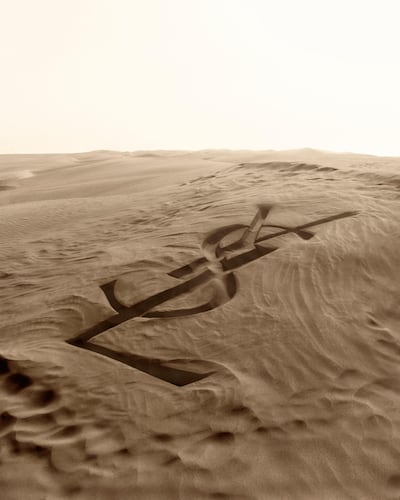The video presentation for Saint Laurent's summer 2021 collection by Anthony Vaccarello begins with the letters "YSL" stamped on to a towering sand dune. Models then appear over the crest of the dune, transforming a stunning stretch of Moroccan desert into a makeshift (and ever-shifting) runway.
Under a sky lightly dusted with clouds, models smoothly navigated this most unstable of surfaces, despite their high heels, showcasing a collection that, unusually for Vaccarello, was centred around comfort.
A thick jersey material, uncovered in the Saint Laurent archive and dating back to the late 1960s, which the brand points out were “uncertain times, just like today”, set the tone. Clothes outlined the body without constricting it, whether in the form of tunics and trousers, a long jacket with tidy pockets, a silk blouse worn with rider shorts or structured-looking jumpsuits.
Towards the end of the presentation, the mood shifts as the dune is engulfed in darkness, lit only by a line of fire.
“I wanted to focus on the essence of things. I think it’s a sign of the times. But I didn’t want anything bleak or heavy. The desert, to me, symbolises that yearning for serenity, open space, a slower rhythm. The clothes are also softer, the spirit of the collection is more gentle, stripped back,” Vaccarello explained.
The label has a longstanding connection to Morocco. Its founder, the famed Yves Saint Laurent, first visited Marrakech in 1966 with his partner Pierre Bergé, and they quickly became captivated by the city. Saint Laurent would go on to write of the city’s “benevolent pink magic”.
Saint Laurent came here twice a year to design his haute couture collections. On June 1 and December 1, he would travel to Marrakech for two weeks at a time, and it is here that he found the space, clarity and inspiration to create.
The city’s influence could be seen in the clothes he created, as the designer drew from local fashions, crafts and colours, and by the billowing silhouettes of the jalabiya and the burnous cape. It is often said that it was here that he “discovered colour”.
“In Morocco, I realised that the range of colours I use was that of the zelliges, zouacs, djellabas and caftans. The boldness seen since then in my work, I owe to this country, to its forceful harmonies, to its audacious combinations, to the fervour of its creativity. This culture became mine, but I wasn’t satisfied with just absorbing it; I took, transformed and adapted it,” he said.



